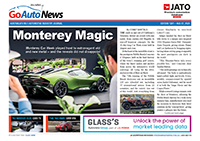 1 Mar 2009
1 Mar 2009
MAZDA released a facelifted MX-5 in Australia in March 2009, boasting improved performance, efficiency, refinement, driving dynamics and comfort.
The makeover is more than a cosmetic nip and tuck though, thanks to increased equipment levels and a comprehensive array of mechanical changes that are designed to increase the iconic convertible’s fun quotient and please purists.
In fact, more ‘fun’ is keeping with the ‘Jinba Ittai – oneness between man and machine’ mantra that is the philosophy of the current-generation MX-5, according to its program manager and chief engineer, Takao Kijima.
The outgoing NC Series 1’s 2003 IBUKI Concept-style oval-themed front fascia is history, replaced by a nose cone featuring a slantier set of headlights with white turn indicators, larger bonnet badge, and corporate five-point air-intake/grille set among a pair of rectangular-shape fog-light surrounds. They aim to visually connect the MX-5 with the latest Mazda3.
Besides the different rear guards and roof, there is increased differentiation between the Soft-top and hardtop as a result of the latter’s mesh grille insert, chrome finish inner bezel for the headlights, silver fog light surrounds, chrome door handle trim, and clear high-mounted stop lamp.
Trainspotters may also spot the new side sills and garnishes, while the rear boasts redesigned tail-lights and a reshaped bumper with detailed changes to the lower garnish area.
Mazda says the makeover improves aerodynamics – the upshot of detailed attention paid to the grille, tyre deflectors, side sills, door mirrors and tail-light shape.
Inside the dash ditches the piano black dash trim for a dark silver item, the instrumentation graphics are further spaced for improved legibility, the trip and odometer is now a backlit LCD, while the audio system has the different header unit from the Mazda6.
The door trims have been redesigned with less protruding cupholders and a netted pocket, soft padding now surrounds the centre console storage box and on the armrests of most models, and there are lashings of metallic-like trim on various buttons and switches.
Occupant comfort increases as a result of better-bolstered seats with new cushion surfaces, while the aforementioned Recaro seats on the Roadster Coupe Sports are finished in leather and Alcantara.
Under the carryover bonnet is a reengineered version of the 1999cc 2.0-litre twin-cam 16-valve four-cylinder petrol engine that debuted in the NC in late 2005.
In models fitted with the six-speed manual gearbox, it still delivers 118kW of power and 188Nm of torque at an unchanged 5000rpm, but peak power is now set 300rpm higher at 7000rpm, while the rev limit is now 500rpm more at 7500rpm.
Automatic MX-5s have a 118kW power limit at 6700rpm and a rev limit of 7000rpm, while the 188Nm torque-top also remains unchanged at 5000rpm.
Mechanical changes on both versions include a forged crankshaft for greater rigidity at higher engine speeds, new fully-floating pistons with higher pin-boss reliability, ‘bounce’ resistant revised valve springs that can occur at higher revs, and connecting rod bearings that use higher-durability materials.
Slightly better performance feel throughout the rev range is the result, while fuel consumption drops by 0.4 and 0.7 litres per 100km for the manual and automatic models respectively, to 8.1L/100km. However, the auto uses a single gram per kilometre less carbon dioxide than the manual, at 191g/km, representing a drop of 8g/km for the manual and 16g/km for the automatic.
Mazda’s engineers have also improved the shift and feel of the manual gearbox, as well as the induction sound of the exhaust system.
Meanwhile, the automatic model’s paddle shifts can now be used without the driver having to slot the lever into manual-shift mode beforehand.
On the driving dynamics front, Mazda’s aim was to return the MX-5 to a feel reminiscent of the lauded NB (1997-2005) model’s steering and handling behaviour.
To this end, and aided by the aerodynamic changes that enhance stability and predictability at higher speeds, the suspension was revised to improve roll performance and impart a more natural feel through corners.
Weight rises slightly across all models, partly due to an increase in sound-deadening materials and noise-quelling actions.
Mazda has also listened to customer feedback by installing a seat-height adjuster on all driver’s seats for the first time in the MX-5’s history.

















